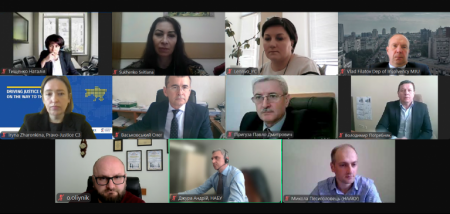Contact center of the Ukrainian Judiciary 044 207-35-46

Oleh Vaskovskyi, Secretary of the Judicial Chamber for Bankruptcy Cases of the Commercial Cassation Court within the Supreme Court, and Volodymyr Pohrebniak, Supreme Court Judge at the Commercial Cassation Court, took part in an online roundtable consultation on ‘Introduction of a simplified bankruptcy procedure for micro, small and medium-sized enterprises (MSMEs) in the context of European integration’, aimed at discussing ways to comprehensively study the insolvency of MSMEs to bring the legislative and institutional framework in this area in line with the EU legislation and law.
The participants discussed methodological aspects of the study, including the definition of clear criteria for identifying MSMEs in bankruptcy cases, and the best ways to interview representatives of such enterprises (or insolvency officers in liquidation proceedings) about the reasons for their financial insolvency. Attention was also paid to the need to obtain relevant statistical information from government agencies and the banking sector for an in-depth analysis of the situation. The key point of discussion was the nature and necessity of introducing a simplified bankruptcy procedure for MSMEs: what specific stages of the existing procedures (property disposal, rehabilitation, liquidation) need to be simplified or eliminated, what key elements the new procedure should contain, what evidence is required to initiate it, how to ensure the availability of bankruptcy instruments and specialist services for MSMEs, what safeguards are needed to avoid abuse, and what should be the optimal duration of the procedure. The participants also discussed the need to amend the Code of Ukraine on Bankruptcy Procedures to introduce a simplified bankruptcy procedure for MSMEs.
During the dialogue, Oleh Vaskovskyi raised the issue of the very concept of a ‘simplified procedure’. He emphasised the need to clearly define what exactly is meant by this term: does it mean only accelerated liquidation, or a procedure that may contain elements of rehabilitation and certain benefits for restoring solvency?
The secretary of the specialised judicial chamber of the CommCC of the Supreme Court noted that the current Code provides for three judicial procedures: property disposal, rehabilitation and liquidation. Therefore, the key is to understand the purpose of the proposed simplification: ‘to liquidate as soon as possible’ or “to grant a privilege for recovery”? The judge emphasised that the answer to this question will determine the design of the future mechanism and its place in the Code of Ukraine on Bankruptcy Procedures.
The judge also reminded that bankruptcy proceedings can be costly and usually depend on the availability of funding, which is a particular problem, especially in the case of ‘abandoned’ companies with no assets and no funds to pay the insolvency officer. In conclusion, Oleh Vaskovskyi stressed the importance of a thorough analysis before implementing any novelties to the bankruptcy law.
Turning to the issue of statistical data collection, Volodymyr Pohrebniak noted that the Ministry of Justice of Ukraine already has a significant amount of data through the administration of registers. He noted that only a small part of bankruptcy cases (about 5-10% of proceedings) reaches the Supreme Court, so in order to obtain a comprehensive analysis, it is necessary to attract data not only from the State Statistics Service of Ukraine and the State Tax Service of Ukraine, but also from the State Judicial Administration of Ukraine.
The online consultation demonstrated the complexity of the task and the existence of different approaches to its solution. The discussion highlighted the need for a thorough analysis of the real needs of MSMEs, a clear definition of the purpose and parameters of the future simplified bankruptcy procedure before amending the legislation.
The consultation was also attended by representatives of the EU Pravo-Justice project, appellate and local commercial courts, the Ministry of Economy of Ukraine, the State Tax Service of Ukraine, the National Bank of Ukraine, the Independent Association of Banks of Ukraine, the National Association of Insolvency Receivers of Ukraine, and interregional departments of the Ministry of Justice of Ukraine.
The event was organised by the Directorate of Justice and Criminal Justice of the Ministry of Justice of Ukraine in pursuance of the Strategy for Recovery, Sustainable Development and Digital Transformation of Small and Medium Enterprises until 2027 and the Ukraine Facility.